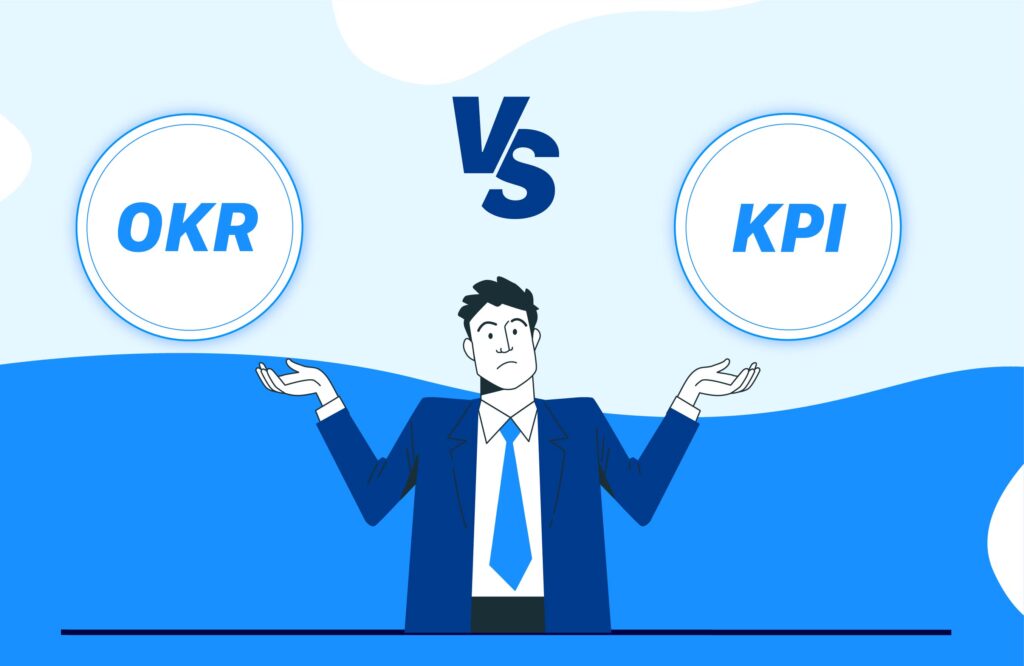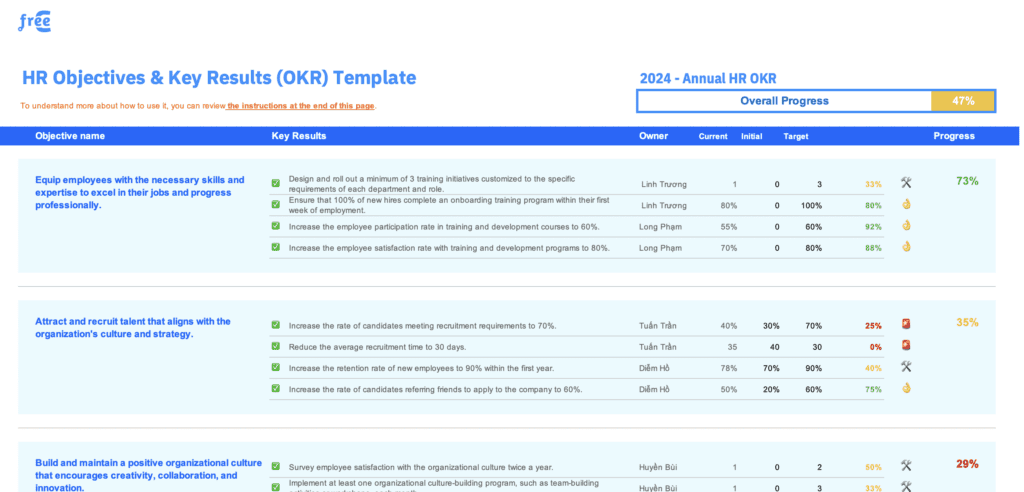Setting objectives and monitoring performance are critical for any organisation in the competitive and changing business world of today. Additionally, the Objectives and Key Results system, or OKRs, is a crucial tool for the Human Resources (HR) department to use in order to increase employee capabilities, boost operational efficiency, and contribute to the overall success of the company.
The following will provide you an overview of HR OKR fundamentals:
- Definition of HR OKR
- Differentiating OKR from KPI
- Useful HR OKR techniques
- Examples of HR OKR metrics and examples
Comprehending HR OKR can assist HR professionals and senior managers in devising plans for their department and in fostering a vibrant, innovative, and alluring work atmosphere for the company.
Now let’s get started on our exploration of HR OKR with freeC Asia !
OKRs for HR: What Are They?
HR departments can develop precise, quantifiable, and goal-oriented goals with the aid of HR OKR, or HR Objectives and Key Results System. It serves as a compass, assisting HR in putting ideas into practice that enhance worker capacity and advance the company’s success as a whole.
Key components of HR OKR:
- Objectives: State the goals HR hopes to accomplish in a specific amount of time. This objective must be Time-bound, Relevant, Specific, Measurable, and Achievable.
- Key Results: Indicate precisely how close a goal is to being completed. Key outcomes must be quantifiable and SMART.
- Initiatives: Particular actions and assignments to complete in order to meet important objectives.
The implementation of HR OKR on an annual or quarterly basis aids in maintaining consistency and continuity in the process of overseeing the performance of the Human Resources division.
Benefits of HR OKR include:
- Increasing employee engagement and dedication
- Fostering a culture of measurement and responsibility
- Improving the Human Resources department’s operational efficiency
- Contributing to the business’s overall success
Any human resources department looking to increase operational effectiveness and support the long-term growth of the company must have HR OKR on hand.
OKR and KPI: similarities and differences.

OKR (Objectives and Key Results) and KPI (Key Performance Indicators) are two common performance management systems used by many firms, including Human Resources (HR) departments. However, there are some significant distinctions between these two systems that should be acknowledged.
Similarities:
- Both OKRs and KPIs serve the same purpose: to monitor and assess operating performance.
- Measurability: Both approaches utilize particular indicators to assess progress and outcomes.
- Focus: Both OKRs and KPIs aim to achieve specified objectives.
Difference:
- The scope of OKRs and KPIs differs in that the former are usually more operational and short-term in nature, while the latter are longer-term and more strategic in nature.
- Flexibility: Unlike KPIs, which are frequently more set, OKRs are frequently fluid and subject to alter over time.
- Application: While KPIs are frequently used to assess both individual and team performance, OKRs are frequently utilized to convey vision and promote employee engagement.
For example:
- OKR goal for HR: Increase employee retention rate to 90% within 1 year.
- OKR key results:
- Reduce the turnover rate within 6 months to 5%.
- Increase employee satisfaction survey participation rate to 80%.
- KPIs for HR:
- Average time to hire a new employee.
- Average training costs per employee.
- Percentage of employees participating in professional development programs.
HR professionals can efficiently use both systems to accomplish objectives and boost performance by knowing the distinctions between OKRs and KPIs.
Why should HR OKRs be established?
The Human Resources division and the company as a whole gain a lot from setting up HR OKRs, including:
1. Boost the effectiveness of operations:
- OKRs assist track and measure progress efficiently, allowing you to make timely strategy adjustments when needed. They help the Human Resources department focus on key goals and benefit the overall success of the business.
- OKRs encourage accountability and openness by making sure that everyone is aware of their duties and roles in accomplishing group objectives.
2. Boost employee involvement and commitment:
- OKRs give staff members a better understanding of the department’s and the organization’s shared objectives, which inspires and motivates them to put in more effort.
- By encouraging goal-setting and progress tracking, OKRs provide employees a sense of respect and value.
- OKRs give staff members the chance to get regular feedback and assessments, which aids in their personal growth and capacity building.
3. Encourage the development of a measurement and accountability culture:
- OKRs aid in the development of this culture in HR, which in turn motivates employees to perform well and accomplish their objectives.
- OKRs support honest, unbiased performance tracking and evaluation, which fosters confidence and trust within the company.
- OKRs assist in identifying the department of human resources’ strengths and weaknesses, from which suitable improvement solutions can be suggested.
4. Contribute to the overall performance of the company:
- By luring, keeping, and nurturing talent, the Human Resources department, when run well, adds to the company’s overall success.
- OKRs aid in ensuring that the business’s overall objectives are consistently the focus of the Human Resources division’s operations.
- The Human Resources department’s influence on the overall performance of the company is measured and assessed with the use of OKRs.
It is a smart move for the Human Resources department to set up HR OKRs in order to boost employee engagement, increase operational efficiency, and contribute to the overall success of the company. Thus, in order to reap these useful advantages, human resource managers ought to think about implementing OKRs in their divisions.
Practices for HR OKRs
1. Modify HR OKR in line with the organization’s overarching objectives.
HR OKRs must be in line with the organization’s overall OKRs in order to maximize performance. Making ensuring that every action taken by the HR division is focused on achieving a single objective and adding value to the company is the primary objective of this.
You must distribute and implement the updated Human Resources OKRs to the appropriate departments, including L&D, recruitment, and… This facilitates efficient coordination and uniformity throughout the implementation process.
Developing distinct KRs (Key Results) for every department is essential for goals that call for departmental collaboration. The groups or people in charge of implementation will be given the ideas required to meet the KR.
Additionally, it is crucial for leaders to communicate and discuss shared objectives. This makes it easier to make sure that the objectives are agreed upon by all parties involved and align with the organization’s overarching direction. To attain the maximum efficiency, the Human Resources department must simultaneously promote cross-functional collaboration.
To put it succinctly:
- Align HR OKRs with overall company OKRs.
- Distribute and implement OKRs among reliant departments.
- Create initiatives and KR that are particular to each objective.
- At the leadership level, communicate and talk about shared objectives.
- Promote interdepartmental cooperation in Human Resources.
You can guarantee that your HR OKRs are executed successfully and contribute to the overall success of your organization by following the aforementioned steps.
2. OKR deployment techniques: top-down and bottom-up
With the use of OKRs, businesses can create strategic goals both top-down and bottom-up.
Top-down methodology:
- The organization’s annual goals are determined by the executive board, or board of directors (BOD).
- Middle managers then break down these goals into particular key results (KRs), frequently with team input in mind.
Bottom-up strategy:
- Colleagues can suggest projects that advance the organization’s overarching objectives and connect themselves with particular KRs.
Support for OKRs must come from both the top down and bottom up. This implies:
- Top management commitment is required: Management must provide resources and demonstrate support for the implementation of OKR.
- All staff members must be involved: Everyone in the company must be made fully aware of OKRs and encouraged to offer suggestions.
Organizations can accomplish their strategic goals with the aid of OKR, a potent instrument. A successful blend of top-down and bottom-up strategies is needed for OKR deployment. However, senior management’s dedication and every employee’s involvement are also critical components in guaranteeing the success of OKRs.
3. Tricks for creating HR OKRs that work
In order to construct a Human Resources OKR that works, you must make sure of the following:
Inspirational and purposeful objectives:
Since the aim sets the course for the entire activity, it must be developed in a way that is clear, concise, and motivating for staff members. Good goals should inspire enthusiasm, dedication, and a desire in everyone to work together to accomplish them.
SMART key results:
Key results (KRs) are specific measures that help evaluate the level of goal accomplishment. To ensure effectiveness, KR needs to meet SMART criteria:
- Specific: KR should clearly state what needs to be achieved, avoid being vague or general.
- Measurable: KR needs to have specific indicators to monitor and evaluate progress.
- Achievable: KR needs to be set at a challenging level but can still be completed with the efforts and abilities of the Human Resources department.
- Relevant: KR needs to be directly related to goals and have a real impact on the performance of the Human Resources department.
- Time-bound: KR needs a specific deadline to complete, create motivation and promote work progress.
Put an emphasis on development and improvement:
HR OKRs should work to enhance employee capabilities, streamline operations, enhance workflows, and enhance overall corporate success. Steer clear of goals that replicate previously completed work or perpetuate the status quo.
Establish reasonable goals:
To guarantee concentration and efficient execution, you should establish one to five goals every quarter. Too many goals might cause the HR department to become sidetracked and hinder their ability to produce the greatest outcomes.
Measure and assess often:
At the very least once a month, it is imperative to keep an eye on and assess how well HR OKRs are being implemented. This makes it easier to pinpoint strengths and shortcomings, change course, and act quickly to address issues so that objectives are met.
By putting the aforementioned ideas into practice, you may create successful Human Resources OKRs that will advance the growth of the HR division, increase operational effectiveness, and boost overall business success.
4. Verify the strategic nature of your HR OKR: Comprehensive procedure

In guiding and encouraging organizational development, OKR is crucial. As a result, creating and executing successful OKRs requires meticulous planning and execution. The whole procedure that Workpath suggests following to make sure your OKRs are strategic is listed below:
Organizational/Personnel Priority Notice:
Every year, the Human Resources division must decide on the main area of focus for its operations. When creating their own OKRs, other departments will follow this general guideline. For instance, HR departments can incorporate automation into their OKRs if automating HR procedures is the year’s top objective. The OKRs for each department will then be developed by the Human Resources managers based on these goals.
Internal meeting:
To agree and align goals, all department heads, OKR owners, and leadership must attend. This meeting’s objectives are to make sure all topics are covered and to resolve any obstacles that might prevent OKRs from being achieved. The meeting also aids in delegating tasks to each OKR concurrently. A meeting of alignment will assist in resolving disputes and reaching a consensus over the implementation schedule, for instance, if an OKR comprises two departments.
Begin OKR:
To introduce all approved OKRs to the entire company, an OKR kickoff is arranged. In order to provide staff members ample time to establish their individual OKRs, this should be completed at the start of the year. The kick-off meeting should foster a dynamic and motivational environment that encourages staff commitment to reaching challenging objectives.
Register:
Both organizational and individual registration for OKR is required. OKRs are frequently established at the start of the year, and over time, workers may forget them. Employees will benefit from ongoing support and updates on the status of the OKR implementation with regular check-ins.
Comments and Reviews:
An assessment of the success, shortcomings, and lessons learned of the OKR implementation must be carried out at the conclusion of every year. The evaluation ought to center on significant inquiries like:
- Do OKRs perform as expected?
- Is the objective overly lofty?
- What obstacles have impeded the adoption of OKR?
Organizations can get valuable insights from the evaluation process and modify their OKR development techniques in subsequent years to optimize efficiency.
5. Ascertain how many KR are needed for each objective.
Key Results (KRs) ought to be measurable, with two to five KRs for each objective. Overdefining Key Results has the danger of diverting team members’ attention.
6. Give each KR a weighted value: Boost the efficiency of OKR
The success of OKR implementation is significantly influenced by the weighted value (%) that is assigned to each Key Outcome (KR). It offers a number of useful advantages, including:
- Set priorities for tasks and endeavors: The relevance of each sub-goal is ascertained by assigning a percentage to each KR, which provides a foundation for efficiently allocating resources and concentrating efforts. When it comes to implementation, activities with a high density will be given precedence.
- Assess the degree of goal completion: To aid in more precise monitoring and assessment of the goal completion level, provide weighted values. We can ascertain the overall degree of objective achievement by computing the completion rate for each KR according to the given weight.
- Assign weight to each KR: This helps to clearly clarify who is responsible for what in terms of departments or personnel that are relevant to the completion of goals. This promotes accountability and openness during OKR implementation.
Example
Assume that “Increase employer brand awareness within the industry” is the overarching objective. The following weighted values can be assigned to the respective KRs:
| Key results | Weight |
|---|---|
| Boost Candidate Conversion Rate | 35% |
| Boost Website Traffic | 30% |
| Boost Brand Rankings on Recruiting Review Sites | 25% |
| Boost Social Media Engagement | 105 |
By giving each KR a weighted value, HR is better able to concentrate its attention on the tasks that will have the most effects on raising brand awareness and ultimately accomplish the overall objective.
An illustration of HR OKR
The HR OKR will vary depending on the HR department. For greater clarification, let’s examine the following cases.
| Department | Goal | Key Results |
|---|---|---|
| Talent Acquisition | Attract and recruit talents that fit the organization’s culture and strategy. | – Increase the percentage of candidates who meet the recruitment requirements to 70%. – Reduce the average recruitment time to 30 days. – Increase the retention rate of new employees to 90% within the first year. |
| Talent Management | Develop and promote employees’ potential, helping them achieve personal goals and contribute to the organization’s overall success. | – Implement a 360-degree performance review program for 100% of employees. – Establish a personal development program for 80% of employees. – Increase the percentage of employees participating in training and development programs to 60%. |
| Performance Management | Fairly and objectively evaluate employees’ job performance, motivating them to improve their work efficiency. | – Implement a new performance management system with clear and measurable evaluation indicators. – Ensure 100% of employees have their performance evaluated at least once a year. – Increase the percentage of employees achieving their performance goals to 85%. |
| Compensation and Benefits | Provide competitive salaries and benefits to attract and retain talent, and motivate them to contribute fully to the organization. | – Review and update employee salaries to ensure market competitiveness. – Implement a new benefits program, including insurance, medical support, leave, and other allowances. – Increase employee satisfaction with salaries and benefits to 90%. |
| Training and Development | Enhance employees’ skills and knowledge to meet job requirements and help them develop their careers. | – Develop and implement at least 3 training programs tailored to the needs of each department and job position. – Ensure 100% of new employees participate in an orientation program within the first week of employment. – Increase the percentage of employees participating in training and development courses to 60%. |
| Organizational Culture | Build and maintain a positive, open organizational culture that encourages creativity, collaboration, and innovation. | – Survey employee satisfaction with organizational culture twice a year. – Implement organizational culture-building programs such as team-building activities, workshops, etc. – Increase the percentage of employees who feel engaged and proud to work at the organization to 90%. |
| Employee Relations | Maintain good relations between management and employees, resolving conflicts and disputes fairly and effectively. | – Establish effective communication channels between management and employees. – Resolve employee complaints quickly and satisfactorily. – Increase the percentage of employees satisfied with their relationship with management to 85%. |
| Employee Retention | Create an attractive and supportive work environment to retain talent within the organization. | – Survey employee engagement levels twice a year. – Implement retention programs such as reward programs, family support programs, etc. – Reduce employee turnover rate to below 5% per year. |
| HR Compliance | Ensure compliance with all HR-related laws and regulations. | – Update and inform employees about all HR-related laws and regulations. – Conduct recruitment, training, performance management, etc., according to regulations. – Avoid violations of HR-related laws and regulations. |
| Employee Health | Promote a healthy lifestyle and improve employee well-being. | – Reduce the rate of employee sick leave due to chronic illness to 10%. – Increase the percentage of employees participating in physical activities to 50%. – Increase the percentage of employees participating in mental health programs to 30%. |
Free example of OKR tracking for HR
Get your HR OKR tracking template by downloading it, then get to work on HR OKRs right away!
Creating and refining a successful OKR declaration for HR departments is crucial to advancing the organization’s development. The success of the business as a whole can be enhanced by Human Resources departments by improving operational efficiency, focusing their efforts, and clearly identifying goals and important results.

Applying OKRs methodically and scientifically with the involvement of all pertinent parties ill yield the best results. Businesses must simultaneously continuously assess and analyze the success of using OKRs in order to make the required adjustments and advancements.
With work and perseverance, OKR may be a helpful tool for HR departments to accomplish their goals and support the long-term growth of the company.
Contact us for a FREE consultation today to learn more about freeC Asia’s headhunting service that can help your company identify the important OKRs for a successful recruitment process.









